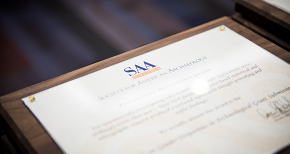Crafting Data-Driven Publications in Archaeology [Foundational Skills]
When: December 04, 2025 2:00-3:00 PM ET
Duration: 1 hour
Certification: RPA-Certified
Pricing
Individual Registration: Free to SAA members; $69 for non-members
Group Registration: Free to SAA members; $89 for non-members
Charles Cobb is the Curator of Historical Archaeology at the Florida Museum of Natural History, with current interests in historical anthropology, Indigenous histories of the American Southeast, and interactions between Native Americans and Europeans in the early colonial era. Charles received his PhD in 1988 from SIUCarbondale, and since that time has worked in a variety of archaeological settings: the CRM industry, academic departments, an archaeological state agency, and currently a natural history museum. Charles' publication record spans 40 years and includes over 40 journal articles, over 30 book chapters, two authored books, two edited books, in addition to a number of technical reports. Charles has a long-standing interest in the application of both quantitative and qualitative methods in archaeology.
- To demonstrate how the concept of research design is foundational to publications and grants.
- To develop the skills to publish in a variety of publication types.
- To raise awareness of the ethical importance of collaborative research and data accessibility.
Introduction to Historic Plastics in the Archaeological Record [Deeper Digs]
When: December 11, 2025 2:00-4:00 PM ET
Duration: 2 hours
Certification: RPA-Certified
Pricing
Individual Registration: Individual Registration: $99 for SAA members; $149 for non-members
Group Registration: Group Registration: $139 for SAA members; $189 for non-members
Kimberly Wooten received her BA in anthropology from the University of California, Santa Barbara, in 1990. She has been a working archaeologist since then, shifting her focus from pre-contact to the fields of post-contact and contemporary archaeology. The potential to explore plastic as an archaeological issue came to her attention in 2018, when she had the opportunity to sail with an all-women crew to research microplastics in the North Atlantic. Kimberly writes and presents on plastic waste, microplastics, and how climate change and other environmental issues can be addressed by the discipline of archaeology. Most recently, she has been teaching about historic-era plastics in the archaeological record, tying those workshops to contemporary archaeology and activism. Ms. Wooten is a recognized expert in the growing field of plastic archaeology. She currently works for the California Department of Transportation as an archaeologist and a climate change specialist.
Julia Huddleson, California Department of Transportation
Julia Huddleson is an historical archaeologist with the California Department of Transportation (Caltrans) where she is the statewide manager of a GIS application and integrated database that tracks cultural resources and projects across California. She has a BA in anthropology from the University of California, Santa Cruz (1991), MS in education from University of Southern California (1991) and an MA in Cultural Resources Management from Sonoma State University (2003). She developed a love of historical archaeology from the post-contact period early in her career and, and since 1997, for Caltrans. Key accomplishments at Caltrans include publication of archaeological research designs for agriculture, mining, townsites, and work camp properties developed with an interdisciplinary team. While working for the Forest Service and Caltrans, she had the opportunity to develop training programs to teach identification of ceramics and other material types from the 19th and early 20th centuries. Most recently, she collaborated with Ms. Wooten to develop a training for identifying plastic types found in the archaeological record.
information provided will inform on industrial commercial and archaeological sites as well. The seminar will conclude with a discussion of the Anthropocene, contemporary plastic archaeology, and time focused on individual solutions to the current plastic pollution crisis. There will be time for Q&A at the end of the session.
2) Provide methods to identify celluloid, Bakelite, and acrylic artifacts.
3) Introduce contemporary archaeological issues associated with plastic.
4) Provide a brief discussion of measures participants can take to reduce their plastic consumption.
Virtual New Member Welcome!
When: January 27, 2026 2:00-3:00 PM ET
Duration: 1 hour
Certification: None
Pricing
Individual Registration: Free to SAA members; Not available to non-members.
Group Registration:
Calling all new members! This webinar is for you. Join SAA president, Christopher Dore, and SAA staff for an interactive webinar on your SAA member benefits and how you can make your membership work for you:
- Learn more about how being an SAA member can help advance your career. Find out about SAA’s continuing education opportunities, committee participation, and awards.
- Learn how the SAA’s government affairs program ensures that policymakers hear your voice. Find out how you can help us defend the archaeological record and archaeological jobs.
- Learn how your SAA membership puts leading research at your fingertips. Find out about journal access, how to contribute, and join an interest group.
As a valued member of the SAA community, this webinar will help you find your niche and launch your network, research, and career to the next level.
- Learn more about how being an SAA member can help advance your career. Find out about SAA’s continuing education opportunities, committee participation, and awards.
- Learn how the SAA’s government affairs program ensures that policymakers hear your voice. Find out how you can help us defend the archaeological record and archaeological jobs.
- Learn how your SAA membership puts leading research at your fingertips. Find out about journal access, how to contribute, and join an interest group.



![Crafting Data-Driven Publications in Archaeology [Foundational Skills]](/images/default-source/default-library/books_overlay.tmb-seminar.png?Culture=en&sfvrsn=db5cbd7e_1)
![Introduction to Historic Plastics in the Archaeological Record [Deeper Digs]](/images/default-source/default-library/copy-of-untitled-design-(1).tmb-seminar.png?Culture=en&sfvrsn=5b34a2fa_1)
.tmb-seminar.png?Culture=en&sfvrsn=47584582_1)